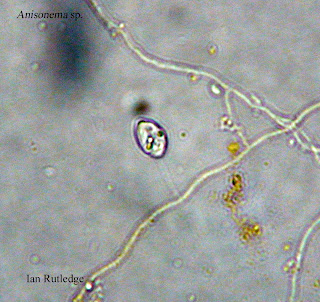On Friday October 25, 2013 "ONE" Beta Food Pellet was inserted into my microaquarium. "Atison's Betta Food" made by Ocean Nutrition, Aqua Pet Americas, 3528 West 500 South, Salt Lake City, UT 84104. Ingredients: Fish meal, wheat flower, soy meal, krill meal, minerals, vitamins and preservatives. Analysis: Crude Protein 36%; Crude fat 4.5%; Crude Fiber 3.5%; Moisture 8% and Ash 15% (McFarland 2013).
It's also possible that the food pellet that was added to my MicroAquarium has contributed to the pollution of the system or at least increased the relative number of particulates in the water. This could be interfering with the mosses and carnivorous plants health.
I got to use the same videomicroscope this week as I did for my observation on Day 9. I was able to find both the euplotes and cyclops I observed last week, as well as a new species.
Picture 2. Euplotes sp. An ovaled shaped euplotes cell with cilia on it's outer membrane and various inner structures that is almost identical to the Euplotes previously observed(Patterson, 1996, p. 124 Figure 259).
Picture 3. Anisonema sp. An anisonema can be seen with it's flagella somewhat hooked on the structure running diagnolly across the frame. It's second flagella can be seen as the dark spot in front of it. It was using the flagella in the front to pull or propel itself along while the longer flagella in the rear stablized it (Pennak, 1953, p. 47 Figure 21-B).
In general, the activity in my MicroAquarium this week seemed to be about the same as last week. I was able to observe relatively similar numbers in multicellular organisms like the euplotes and cyclops, while smaller unicellular organisms like the anisonema were slightly more abundant. Other than the anisonema, I was unable to identify any new organisms.



No comments:
Post a Comment